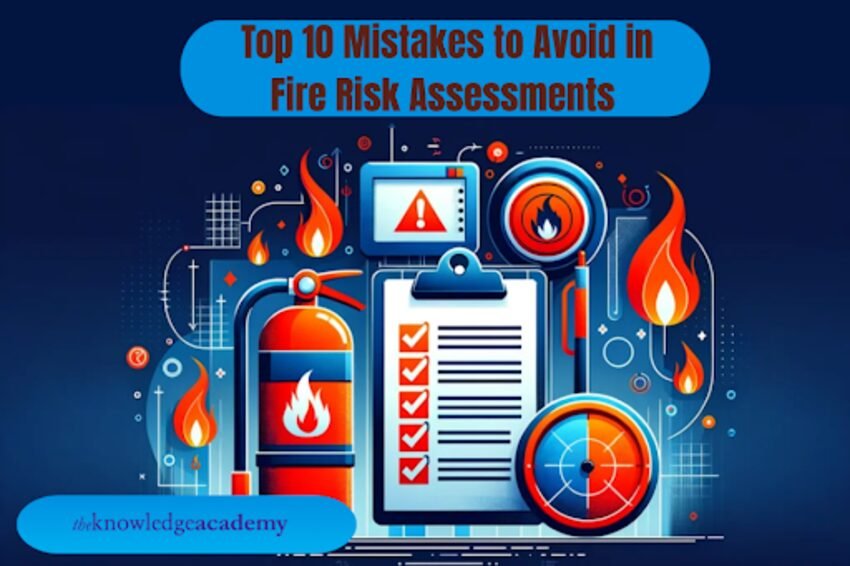The first step in maintaining compliance and saving lives is having the right Fire Safety knowledge. For this reason, it’s a good idea to begin with a Fire Safety Certification Course. It provides you with the assurance to complete assessments accurately and steer clear of typical traps. Adhering to an appropriate Fire Safety Risk Assessment Checklist is crucial, regardless of the size of the institution you are operating. However, a lot of people continue to make careless errors that endanger both persons and property.
In this blog, we will discuss what to avoid to ensure the safety and efficacy of your examination.
1. Not Reviewing Assessments Regularly
Fire risks are never static. If you don’t review assessments often enough, you risk missing new hazards. Below are the key reasons why regular reviews are essential.
- At least once every year, review your fire risk assessment.
- If the equipment, personnel, or layout have changed, review sooner.
- To remain proactive, schedule reminders for your upcoming evaluation.
- Maintain a record of the completion and updates of evaluations.
2. Overlooking Everyday Fire Hazards
Some of the biggest risks are the ones hiding in plain sight. Below are the common daily hazards that are often missed.
- Look for anything combustible close to heat sources.
- Maintain your appliances and get rid of broken ones.
- Don’t disregard paper clutter or overloaded plugs.
- To find the little things, use your fire safety risk assessment checklist.
3. Not Involving the Whole Team
Fire safety is everyone’s responsibility, not just management’s. Here are the ways to make fire safety a team responsibility.
- Educate teams on fire risks in their own areas.
- Include team members in regular fire safety briefings.
- Encourage people to report hazards as they see them.
- Share roles and expectations clearly during fire drills.
4. Failing to Record Findings Properly
If it’s not written down, it might as well not exist. Below are the key steps for thorough and effective documentation.
- Document all identified hazards clearly and in detail.
- Record who is responsible for addressing each risk.
- Note how and when the issues will be resolved.
- Store records where they are accessible during inspections.
5. Ignoring the Importance of Fire Drills
Practising responses saves time and lives during a real emergency. Here are the reasons why fire drills should never be skipped.
- Hold regular fire drills for all teams.
- Practise using different exits and scenarios.
- Appoint fire marshals and ensure they’re trained.
- Review performance after each drill and improve where needed.
6. Not Updating Fire Safety Training
Outdated knowledge is dangerous knowledge when it comes to fire safety. Below are the ways to keep fire safety knowledge up to date.
- Provide refresher training regularly instead of once.
- Train new starters as part of their induction.
- Use a certified Fire Safety Certification Course to stay compliant.
- Make sure training reflects current regulations and your workplace setup.
7. Poor Use of Signage and Alarms
Alarms and signs are useless if no one sees or hears them. Here are the common signage and alarm mistakes to avoid.
- Ensure fire exit signals are clear and well-placed.
- Keep escape routes and signage free from obstructions.
- Test fire alarms and emergency lights on a regular basis.
- Use clear wording and standard symbols for better understanding.
8. Assuming Equipment is Always Ready
Fire safety tools only help if they’re functional when needed. Below are the checks needed to ensure equipment works when needed.
- Inspect fire extinguishers and emergency lighting monthly.
- Keep a checklist for fire equipment maintenance.
- Store equipment in easily accessible areas.
- Replace or repair faulty equipment immediately.
9. Lack of Clear Emergency Plans
Unclear plans create panic. Everyone needs to know what to do. Let’s discuss the essentials for creating and sharing a strong plan.
- In public spaces, post your emergency protocols.
- Assign positions such as first responders and fire marshals.
- Go over the plan with both new and current employees.
- Every time something changes, review and revise the plan
10. Relying on Generic Templates
One-size-fits-all checklists often miss your specific risks. Here are the reasons why your checklist should be customized.
- Your fire Safety Risk Assessment Checklist should be customized for your location.
- Examine your property and note any special dangers.
- Consult with team members who operate in various time zones.
- Regularly update the checklist to account for modifications.
Conclusion
By avoiding these errors, you may guarantee complete dedication towards Fire Safety Requirements and make your workplace safer. You can gain the knowledge required to conduct assessments accurately and confidently by learning from a suitable Fire Safety Certification Course. The Knowledge Academy provides thorough courses tailored to your needs if you’re looking for reliable resources and professional training.
Read Dive is a leading technology blog focusing on different domains like Blockchain, AI, Chatbot, Fintech, Health Tech, Software Development and Testing. For guest blogging, please feel free to contact at readdive@gmail.com.





